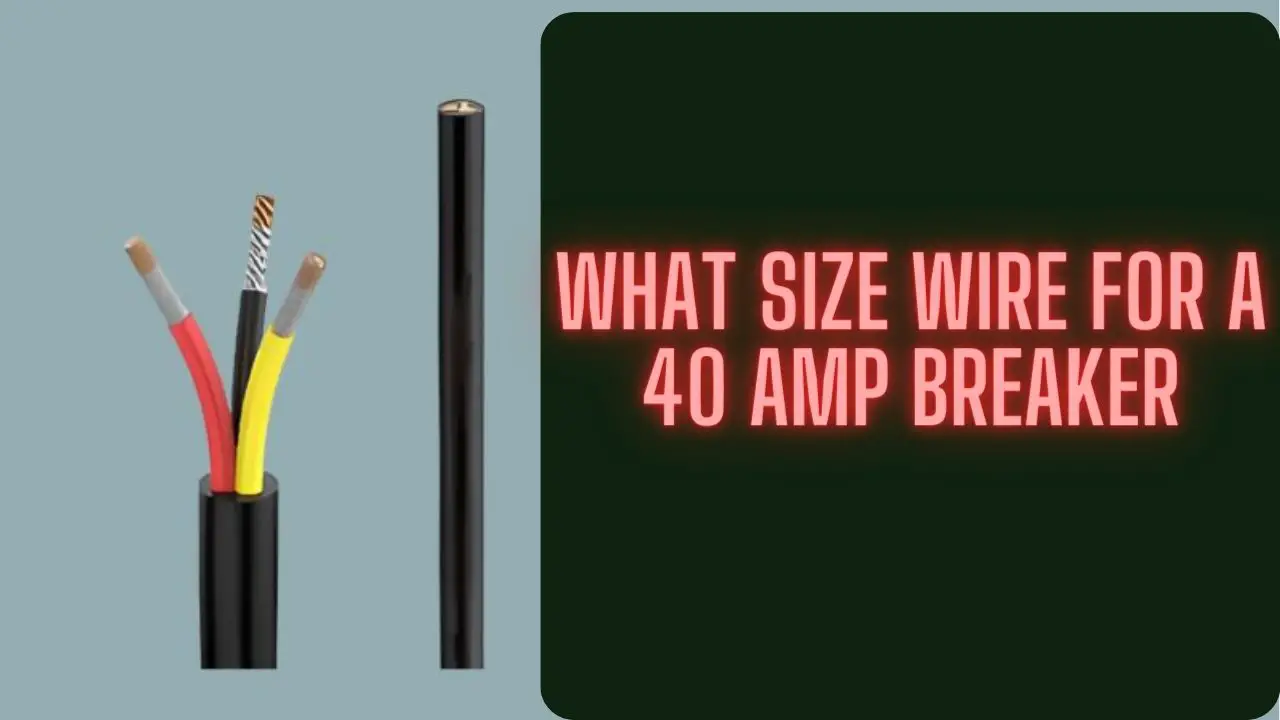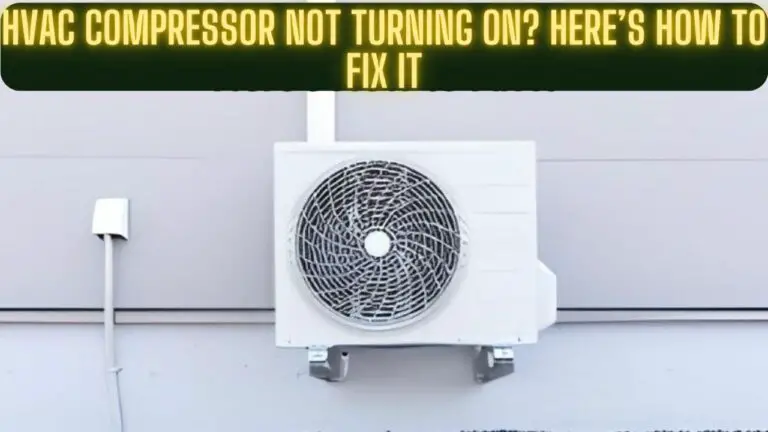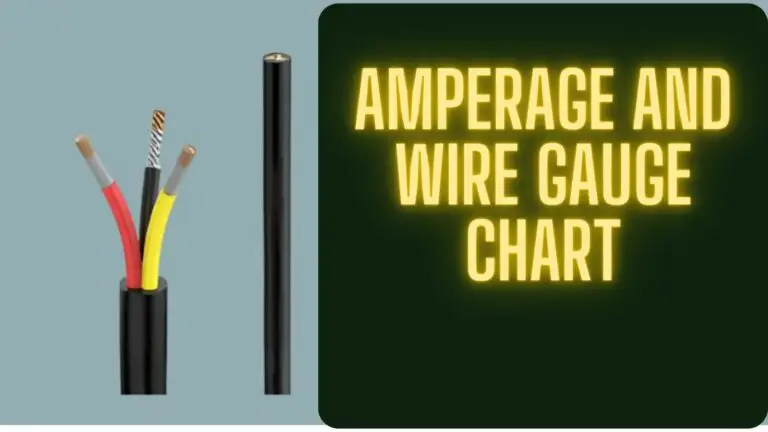What Size Wire For a 40 Amp Breaker? Comprehensive Guide
Introduction
When it comes to electrical installations, selecting the appropriate wire size for a specific circuit breaker is crucial for safety and efficiency. If you’re working with a 40 amp breaker, you need to ensure that the wire size can handle the current without overheating or causing other electrical issues. In this article, we’ll guide you through the process of determining the right wire size for a 40 amp breaker and highlight important considerations.
1. Determine the Wire Gauge: The wire size you need for a 40 amp breaker depends on the distance the wire will run and the type of wire you’re using. Typically, a 40 amp breaker requires a wire size of 8 AWG (American Wire Gauge) for copper conductors. However, if the wire run is long or if the circuit experiences high temperatures, you might need to use a larger wire size to account for voltage drop and heat dissipation.
2. Consider Voltage Drop: Voltage drop occurs when the electrical current encounters resistance in the wire, resulting in a decrease in voltage as it travels from the source to the load. To minimize voltage drop, especially over longer wire runs, you may need to use a larger wire gauge. Voltage drop can affect the efficiency and performance of your electrical system.
3. Choose the Right Type of Wire: When selecting wire for a 40 amp breaker, it’s important to choose the appropriate type of wire insulation. For indoor installations, THHN (Thermoplastic High Heat-resistant Nylon) or similar types of wires are commonly used. For outdoor or wet locations, you may need to use wires with appropriate insulation, such as THWN (Thermoplastic Heat and Water-resistant Nylon).
4. Consult Local Electrical Codes: Always consult your local electrical codes and regulations before installing electrical wiring. These codes may specify minimum wire sizes based on the ampacity (current-carrying capacity) of the circuit and the specific application.
5. Factors Affecting Wire Size: Several factors can influence the choice of wire size for a 40 amp breaker:
- Distance: Longer wire runs may require larger wire sizes to compensate for voltage drop.
- Ambient Temperature: Higher temperatures can affect wire performance, so consider the environment where the wire will be installed.
- Type of Load: Different types of loads (e.g., motors, lighting, heating) have varying current demands, affecting wire size selection.
6. Seek Professional Advice: If you’re unsure about the appropriate wire size for your 40 amp breaker installation, it’s advisable to consult with a licensed electrician. They can provide expert guidance based on your specific circumstances, ensuring compliance with safety standards and electrical codes.
Ideal Wire Size for 40 Amp Breakers
The ideal wire size for a 40 amp breaker depends on several factors, including the type of wire insulation, the length of the wire run, and the specific application. Generally, a 40 amp breaker requires a wire size of 8 AWG (American Wire Gauge) for copper conductors. However, it’s essential to consider the following factors when determining the ideal wire size:
- Wire Material: Copper is the most common conductor material for residential and commercial wiring due to its excellent conductivity. Aluminum wire can also be used, but it requires a larger wire size than copper to carry the same current.
- Wire Insulation Type: Different wire insulation types are designed for specific environments and conditions. Common types include THHN (Thermoplastic High Heat-resistant Nylon) for indoor applications and THWN (Thermoplastic Heat and Water-resistant Nylon) for outdoor and wet locations.
- Voltage Drop: Longer wire runs can result in voltage drop, which can affect the efficiency of your electrical system. To minimize voltage drop, you might need to use a larger wire size. Voltage drop calculations take into account the distance of the wire run, the load current, and the wire’s resistance.
- Ambient Temperature: High temperatures can impact the performance of the wire. If the wire will be installed in an area with elevated temperatures, you might need to adjust the wire size accordingly.
- Application: The type of load connected to the 40 amp circuit can also influence wire size selection. Different loads (such as motors, lighting, or heating equipment) have varying current demands.
- National and Local Codes: Always refer to the National Electrical Code (NEC) and local electrical codes for wire sizing requirements. These codes provide guidelines for safe and compliant wiring installations.
It’s important to note that using a wire size smaller than recommended can lead to overheating, voltage drop, and potential safety hazards. On the other hand, using a larger wire size than necessary can result in unnecessary costs. To determine the precise wire size for your specific situation, consider consulting with a licensed electrician who can perform voltage drop calculations and ensure compliance with codes and regulations.
Wire Size Guidelines
Wire size guidelines are essential for ensuring electrical safety and compliance with regulations. Here’s an overview of the typical guidelines:
- Ampacity Ratings: Understand the ampacity ratings of wires, which represent the maximum continuous current a wire can carry without exceeding its temperature rating. This is crucial for preventing overheating and potential fire hazards.
- National Electrical Code (NEC): Consult the NEC or local electrical codes for specific requirements regarding wire size selection based on the application, environment, and load requirements. The NEC provides tables and guidelines for selecting the appropriate wire size for various amperage ratings.
- Voltage Drop Consideration: Factor in voltage drop considerations, especially for long wire runs or high-power applications. Voltage drop can affect the performance of electrical equipment and should be kept within acceptable limits.
- Wire Type and Insulation: Choose the appropriate wire type and insulation based on the installation environment, such as indoor, outdoor, wet locations, or conduit installations. Common types include THHN/THWN, NM (Romex), and USE.
- Wire Size Calculation: Calculate the required wire size based on the maximum current draw of the connected load and the allowable voltage drop. Use formulas or online calculators to determine the minimum wire gauge needed for the application.
- Temperature Ratings: Consider the temperature ratings of wires, especially when they’re expected to operate in high-temperature environments. Ensure that the selected wire can handle the expected temperature without degradation or insulation damage.
- Overcurrent Protection: Ensure that the wire size is compatible with the overcurrent protection device (circuit breaker or fuse). The wire size should be suitable for the rating of the protective device to prevent overloading and damage to the wire.
- Professional Consultation: When in doubt or dealing with complex installations, consult with a licensed electrician or electrical engineer. They can provide expert guidance and ensure compliance with safety standards and regulations.
By following these wire size guidelines, you can select the appropriate wire size for your electrical installations, ensuring safety, reliability, and compliance with regulatory requirements.
Wire Size Table
Here’s a simplified wire size table based on the National Electrical Code (NEC) guidelines for common wire types used in residential and commercial electrical installations. This table provides general recommendations for wire sizes based on the ampacity rating of the wire and the current-carrying capacity required for various amperage loads:
| Amperage Rating | Copper Wire (THHN/THWN) | Aluminum Wire (THHN/THWN) |
|---|---|---|
| 15A | 14 AWG | 12 AWG |
| 20A | 12 AWG | 10 AWG |
| 30A | 10 AWG | 8 AWG |
| 40A | 8 AWG | 6 AWG |
| 50A | 6 AWG | 4 AWG |
| 60A | 6 AWG | 4 AWG |
| 70A | 4 AWG | 2 AWG |
| 80A | 4 AWG | 2 AWG |
| 90A | 3 AWG | 1 AWG |
| 100A | 3 AWG | 1 AWG |
| 125A | 2 AWG | 1/0 AWG |
| 150A | 1 AWG | 2/0 AWG |
| 175A | 1/0 AWG | 3/0 AWG |
| 200A | 1/0 AWG | 3/0 AWG |
| 225A | 2/0 AWG | 4/0 AWG |
| 250A | 3/0 AWG | 250 kcmil |
| 300A | 4/0 AWG | 350 kcmil |
| 350A | 250 kcmil | 400 kcmil |
| 400A | 350 kcmil | 500 kcmil |
| 450A | 400 kcmil | 600 kcmil |
| 500A | 500 kcmil | 750 kcmil |
| 600A | 600 kcmil | 1000 kcmil |
Note:
- The table provides wire sizes for both copper and aluminum wires based on THHN/THWN insulation.
- Always verify with the NEC or local electrical codes for specific requirements and conditions.
- Consult with a qualified electrician for installations involving wire sizes larger than those listed or for more complex applications.
- Pay attention to derating factors, temperature ratings, and other installation requirements as specified by the NEC or local codes.
Installation Considerations
Installation considerations are crucial for ensuring the safety, reliability, and compliance of electrical wiring systems. Here are some important factors to consider during the installation process:
- Location and Environment: Assess the installation location to determine whether it’s indoors, outdoors, in a wet environment, or exposed to extreme temperatures. Choose wiring and equipment that are suitable for the specific environmental conditions.
- Wire Routing and Protection: Plan the routing of wires to minimize exposure to physical damage, such as impact, abrasion, or puncture. Use conduit, raceways, or protective channels where necessary, especially in high-traffic areas or where wires are exposed to potential hazards.
- Spacing and Separation: Maintain proper spacing and separation between electrical wires and other building components, such as framing members, insulation, and plumbing lines. Avoid running wires parallel to or near sources of electromagnetic interference (EMI), such as power cables or motors.
- Overcurrent Protection: Install the appropriate overcurrent protection devices, such as circuit breakers or fuses, to safeguard the electrical wiring system from overload conditions. Ensure that the rating of the protection device matches the ampacity of the wire to prevent overheating and fire hazards.
- Grounding and Bonding: Implement proper grounding and bonding techniques to minimize the risk of electric shock and equipment damage. Connect grounding conductors to grounding electrodes and metal enclosures according to code requirements.
- Voltage Drop: Calculate and mitigate voltage drop in long wire runs or high-power circuits to maintain adequate voltage levels at the point of use. Use larger wire sizes or voltage drop correction methods as necessary to compensate for voltage loss.
- Temperature Ratings: Select wires, connectors, and equipment with temperature ratings that are compatible with the expected operating temperatures. Avoid exceeding the maximum temperature ratings to prevent insulation degradation and equipment failure.
- Accessibility and Maintenance: Ensure that electrical components, such as junction boxes, panels, and disconnect switches, are accessible for inspection, testing, and maintenance purposes. Provide adequate clearance and labeling for easy identification of circuits and components.
- Compliance with Codes and Standards: Adhere to applicable electrical codes, regulations, and industry standards, such as the National Electrical Code (NEC) in the United States or equivalent standards in other regions. Obtain permits and inspections as required by local authorities.
- Professional Installation: Whenever possible, enlist the services of qualified electricians or electrical contractors for the design, installation, and inspection of electrical wiring systems. Professional expertise ensures compliance with safety standards and reduces the risk of errors or deficiencies.
By considering these installation considerations, you can help ensure the safety, reliability, and compliance of electrical wiring systems in residential, commercial, and industrial applications.
Compliance and Safety
Compliance and safety are paramount in electrical installations to protect both people and property from hazards. Here’s an overview of key aspects related to compliance and safety:
- Adherence to Codes and Regulations: Follow applicable electrical codes, standards, and regulations established by national, state, or local authorities. In the United States, this often means compliance with the National Electrical Code (NEC) or other relevant standards such as those set by the International Electrotechnical Commission (IEC) or the Institute of Electrical and Electronics Engineers (IEEE).
- Permitting and Inspection: Obtain necessary permits for electrical work and ensure that installations are inspected by authorized personnel according to regulatory requirements. Inspections help verify compliance with code standards and identify potential safety issues before they become hazards.
- Equipment Certification and Listing: Use electrical equipment, components, and materials that are certified and listed by recognized testing laboratories. Certification ensures that products meet safety and performance standards established by industry organizations.
- Proper Equipment Selection: Select electrical equipment, devices, and components that are suitable for the intended application and environment. Consider factors such as voltage ratings, current ratings, temperature ratings, and environmental conditions to ensure safe and reliable operation.
- Safe Installation Practices: Follow safe installation practices outlined in codes, standards, and manufacturer instructions. This includes proper wiring techniques, securing of conductors, correct termination of connections, and appropriate use of protective devices such as circuit breakers, fuses, and ground-fault circuit interrupters (GFCIs).
- Grounding and Bonding: Implement effective grounding and bonding methods to minimize the risk of electric shock, equipment damage, and fire hazards. Ensure that grounding conductors are properly connected to grounding electrodes and bonded to metal enclosures according to code requirements.
- Arc Flash and Arc Fault Protection: Mitigate the risk of arc flash and arc fault incidents by implementing appropriate protective measures, such as using arc-resistant equipment, installing arc fault circuit interrupters (AFCIs), and following safe work practices for electrical maintenance and troubleshooting.
- Personal Protective Equipment (PPE): Provide and use appropriate PPE, such as insulated gloves, safety glasses, and protective clothing, when working on or near energized electrical systems. PPE helps prevent injuries from electric shock, arc flash, and arc blast events.
- Training and Education: Ensure that personnel involved in electrical work receive adequate training and education on safety practices, hazard recognition, and emergency procedures. Ongoing training helps maintain awareness of potential risks and promotes a culture of safety in the workplace.
- Documentation and Record-Keeping: Maintain accurate documentation of electrical installations, modifications, inspections, and maintenance activities. Keep records of equipment specifications, test results, permits, and inspection reports for reference and compliance purposes.
By prioritizing compliance with codes and standards and implementing robust safety measures, you can minimize the risk of electrical hazards and promote a safe working environment for individuals involved in electrical installations and maintenance.
FAQS
What size wire is typically used for a 40 amp breaker?
For a 40 amp breaker, the most common wire size is 8 AWG (American Wire Gauge) for copper conductors. However, the ideal wire size can depend on factors like wire insulation type, voltage drop considerations, and the specific application.
Can I use a smaller wire size for a 40 amp breaker installation?
Using a smaller wire size than recommended can lead to overheating, voltage drop, and potential safety hazards. It’s important to follow the recommended wire size guidelines based on factors like the distance of the wire run, ambient temperature, and load type.
What happens if I use a larger wire size for a 40 amp breaker?
Using a larger wire size than necessary doesn’t usually cause harm, but it can result in unnecessary costs. However, it’s important to ensure that the larger wire size still fits within the breaker terminals and any associated connectors.
How do I calculate voltage drop for a 40 amp breaker installation?
Voltage drop calculations consider factors like wire length, load current, wire resistance, and acceptable voltage drop percentage. There are online calculators and formulas available to help you determine the voltage drop for your specific installation.
Can I use aluminum wire for a 40 amp breaker?
Aluminum wire can be used for a 40 amp breaker, but it typically requires a larger wire size compared to copper conductors to carry the same current. Consult electrical codes and guidelines for the appropriate aluminum wire size.
What type of wire insulation should I use for a 40 amp breaker?
Choose wire insulation types based on the installation environment. THHN (Thermoplastic High Heat-resistant Nylon) is commonly used for indoor applications, while THWN (Thermoplastic Heat and Water-resistant Nylon) is suitable for outdoor and wet locations.
Are there specific wire color codes I should follow for a 40 amp breaker?
Wire color codes may vary depending on your location and electrical codes. In North America, black or red wires are commonly used for hot conductors, white or gray for neutral conductors, and green or bare for ground conductors. Always follow local electrical codes.
Can I use a wire size smaller than 8 AWG for a 40 amp breaker?
Using a wire size smaller than the recommended 8 AWG for a 40 amp breaker is not advisable. It can lead to overheating, voltage drop, and safety risks. Always follow proper wire sizing guidelines.
Should I consult a professional electrician for wire sizing?
If you’re unsure about the appropriate wire size for your 40 amp breaker installation, it’s recommended to consult a licensed electrician. They can perform voltage drop calculations and ensure compliance with electrical codes.
Can I install the wire myself for a 40 amp breaker installation?
While some electrical work can be done by homeowners, it’s recommended to have a professional electrician install or replace wiring, especially for higher current circuits like a 40 amp breaker. A licensed electrician can ensure proper installation and adherence to safety standards.
Conclusion
Selecting the right wire size for a 40 amp breaker involves considering factors like wire length, voltage drop, ambient temperature, and load type. While 8 AWG copper wire is often suitable for this application, it’s important to factor in all relevant considerations and adhere to local electrical codes to ensure a safe and efficient electrical installation. When in doubt, consulting with a professional electrician is the best way to make informed decisions.







